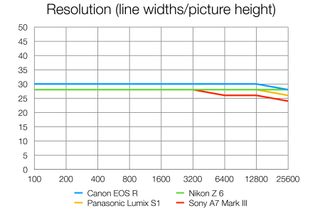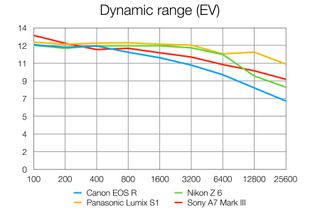Digital Camera World Verdict
A capable but conservative full-frame mirrorless camera, it boasts crisp 30.3MP imaging and unlocks the door to Canon's spectacular RF-mount lenses. Even so, there are enough compromises – the cropped 4K, single memory card slot and lack of IBIS – that its rivals from Sony, Nikon and Panasonic make more compelling options, and it also faces stiff competition from the EOS RP.
Pros
- +
Great control customization
- +
5,655(!) focus positions
- +
Fully articulating screen
- +
M-Fn Bar
Cons
- -
No in-body stabilization
- -
Cropped 4K video
- -
Single SD card slot
- -
M-Fn Bar
Why you can trust Digital Camera World
When it launched in 2018, the Canon EOS R was criticized for some of its puzzling limitations. However, two years later – with a lower price tag, some firmware improvements and a mature RF lens lineup – the EOS R is both a more compelling and more capable camera than it was at launch.
Where does the Canon EOS R rank among the best Canon cameras in 2020? It squeezes more out of its 30.3MP sensor thanks to improved AF, producing images comparable to the mighty Canon EOS 5D Mark IV. Its cropped 4K video is a sore point next to the best 4K cameras, but it still delivers beautiful footage in both Ultra and Full HD.
Clearly the headline-grabbing Canon EOS R5 is a cut above, with a full suite of features including IBIS, dual card slots, a joystick, and of course 45MP images and 8K video. And while the Canon EOS RP is a junior model, its lower price point married with only slightly lower performance (still packing an impressive 26.2MP sensor) makes it a very attractive alternative.
Still, in terms of raw resolution, the EOS R is Canon's top mirrorless contender next to the flagship R5. So how does the camera hold up in 2020?
Read more: Canon EOS RP vs EOS R | Canon EOS R vs Sony A7 III
Specifications
• Sensor: 30.3MP full frame CMOS, 36 x 24mm
• Lens mount: Canon RF
• In-body image stabilization: No
• Image processor: Digic 8
• AF points: 5,655 Dual Pixel AF positions
• ISO range: 100 to 40,000 (exp. 50 to 102,400)
• Max image size: 6,720 x 4,480
• Metering modes: Evaluative, partial, spot, centre-weighted
• Video: 4K UHD at 29.97p, 25p, 24p, 23.98p
• Viewfinder: EVF, 3.69m dots, 100% coverage
• Memory card: SD / SDHC / SDXC
• LCD: 3.15-inch fully articulating touchscreen, 2.1m dots
• Max burst: 8fps
• Connectivity: Wi-Fi, Bluetooth, NFC
• Size: 135.8 x 98.3 x 84.4mm (body only)
• Weight: 580g (body only; 660g with battery and card)
Key features
In some respects, the Canon EOS R is positioned squarely in the middle of its mirrorless lineup. It boasts a full-frame 30.3MP CMOS sensor, which is on par with the 5D Mark IV DSLR.
The two sensors share much in common, the key difference being that the EOS R features a phase-difference detection system with the 1D X Mark II’s Dual Pixel CMOS AF – and a staggering 5,655 focus positions, which cover 88% of the frame horizontally and 100% vertically.
It is unique in the product range in possessing the M-Fn multi-function touch bar – an experiment that was quickly abandoned, as many users felt it was poorly positioned and inconsistent enough to be most useful when turned off, though we actually found it a useful input.
The 3.69 million-dot electronic viewfinder and 3.15-inch, 2.1 million-dot articulating touchscreen both remain more than serviceable, though higher resolutions (and higher refresh rates) mean they're unspectacular by 2020 standards.
Video

Sadly the EOS R takes another, less fortunate cue from the 5D Mark IV: its 4K video comes with the same 1.7x crop, which affects depth of field and means that your RF and EF lenses won't be as wide (a 24mm lens becomes 40.8mm). The good news is that it comes with C-Log and can record internally at 4:2:0 8-bit with Rec. 709 color space, and externally at 4:2:2 10-bit with Rec. 2020 – though it maxes out at 4K 30fps and 1080p 60fps.
In terms of EF and EF-S-mount lenses, the EOS R (and indeed the R system as a whole) achieves native performance with almost the entire range of DSLR optics (with the exception of a handful of older glass) thanks to the EF-EOS R mount adapter (often bundled with the camera).
This means that you can upgrade your body and keep using your existing lenses, as well as take advantage of all the current Canon glass if it isn't yet available in (or if it's cheaper than) an RF equivalent. Furthermore, the Drop-In Filter Mount Adapters also add polarizing or variable ND filters to any EF or EF-S lens.
The EOS R also boasts an impressive ISO range of 100-40,000 (expandable to 50-102,400) and is capable of autofocusing down to -6EV, making it exceptional for shooting in low light situations. If you enjoy night photography or you shoot a lot of weddings in dimly lit venues, this could be a real difference maker. And of course, if you're looking for the best camera for astrophotography, the stargazing specialist Canon EOS Ra is the only dedicated full-frame astro cam available.
Build and handling

If the innards fall somewhat short of expectations, the EOS R’s exterior unquestionably exceeds them. The magnesium alloy body screams “quality”, feeling as robust as it does fantastic to hold. As you’d expect, it’s dramatically more svelte than its DSLR cousins; where the 5D Mark IV is a thick-cut oven chip, the EOS R is a french fry.
This does, of course, lead to the inevitable situation where larger lenses – the Canon RF 85mm f/1.2L USM and particularly the Canon RF 28-70mm f/2L USM – feel unbalanced on the smaller body. This can be offset, though, by adding the BG-E22 Battery Grip (which, unlike Nikon’s MB-N10 Multi-Power Battery Pack for its Z bodies, has a shutter and control dial for vertical shooting).
Which isn’t to say that larger lenses don’t handle well enough on the EOS R; even the above two lenses are manageable for anyone who has lugged around a 1D X with a zoom lens. Thankfully, though, there are now a range of smaller RF optics on the docket, including the brilliant Canon RF 35mm f/1.8 Macro STM.
Whichever RF lens you opt for, in front of the manual focus ring you will notice an additional input: the Control ring. This can be programmed (or left inactive, if you prefer) to adjust aperture, shutter, white balance or ISO, offering an extra dimension of control and customization. Videographers, for instance, will jump for joy at the ability to have a cinema-style aperture ring. This input can also be added to any EF or EF-S lens with the Control Ring Mount Adapter.

As noted, the touch-sensitive M-Fn Bar received a mixed reception, though we find it genuinely useful. We set ours so that a touch, tap or swipe would manipulate the ISO, enabling us to control the entire exposure triangle without taking our eye away from the EVF. It can be turned off entirely if you prefer, or locked so that it doesn’t activate until you hold your thumb on the left side for one second.
Your loving or loathing of the the M-Fn Bar will depend on the size of your hands and how you hold your camera. Photographers with bigger mitts tend to support the body with their thumb right where the Bar sits, leading to some unfortunate button pressing. And of course, it sits right where a joystick could live – but for that, you'll need to opt for the Canon EOS R6 or R5.
In its stead, the EOS R features 'Touch and drag'. This enables you to use half of the LCD as one big trackpad when you look through the EVF, dragging your thumb across the screen as you would a joystick to select your focus point. Again, the size and stretch of your paws will dictate how elegant a solution this is for you, but we had no problems gliding across the 5,655 focus points.
Performance


The EOS R’s 30.3MP sensor, Digic 8 processor and RF lenses deliver formidable image quality. In our lab tests it blew away the Canon 5D Mark IV, Sony A7R III and Nikon Z7 in terms of ISO noise performance, but then the 5D Mark IV is an older camera and the A7R III and Nikon Z 7 are built for resolution, not low light.
As a result, the EOS R didn’t fare as well in the resolution stakes – but that’s no surprise against the Z7’s 45.7MP and the A7R III’s 42.4MP sensors. The EOS R demonstrated better dynamic range than the Sony up to ISO400, but across the board it couldn’t quite keep up with its rivals on paper.
Direct comparisons are made more difficult by the EOS R's intermediate positioning. Nikon, Sony and Panasonic each produce an affordable 24MP all rounder and a more expensive high-resolution model – the EOS R sits between these two types and is hard to classify.
The tests revealed some interesting differences with the 5D Mark IV, from which many might be upgrading. The sensors in both bodies seemed so similar that we expected their performance to be identical; the DSLR, however, scores slightly higher in color accuracy and dynamic range, and in resolution up to ISO800.

Swipe to see all of the images

Swipe to see all of the images

Swipe to see all of the images

Swipe to see all of the images

Swipe to see all of the images

Swipe to see all of the images

Swipe to see all of the images
When it comes down to brass tacks, the practical results produced by the EOS R are hard to fault. Stress tested in the harsh midday sun and the black of the midnight hour, image quality is uniformly impressive and the files handle almost identically to those of the 5D Mark IV in post production.
That magical 'Canon color science' that everyone talks about is as good as ever; when it comes to skin tones the A7R III isn’t in the same league and, while the Nikon is closing the gap, the Z7 still has catching up to do.
Even against Canon's latest bodies, images from the EOS R still fare favorably. Obviously they can't match the resolution of the 45MP R5, but they significantly outpunch the 20.1MP R6 as well as the 24.2MP RP. Low light shooting really is impressive; even a kiss of light is enough for the EOS R to find focus and it delivers crisp, clean results.
The same can't quite be said of its video, however. The 1.7x crop on its 4K is hard to overlook and even harder to forgive, especially when it's capped at 30fps. The 1080p mode is uncropped, of course, but is limited to 60fps – for 120fps slow-motion, you'll need to drop right down to 720p. In short, while the EOS R is still a solid performer for stills, it's far from the best camera for filmmaking in today's market.
Lab tests
We've picked three key rivals for the Canon EOS R to see how they compare in our image quality lab tests. It's a tricky choice because the EOS R is pitched in a kind of no-man's-land between higher resolution but pricier full frame cameras like the Nikon Z7 and Sony A7R Mark IV, and cheaper lower resolution models like the Nikon Z6 and Panasonic S1. Given that EOS R prices are falling, we've updated our charts to include its lower-cost rivals to see what, if anything, the EOS R can do to justify its price difference.

Resolution
The EOS R's 6-megapixel advantage over the Nikon Z6, Panasonic S1 and Sony A7 III give it a small advantage in our lab tests, though it's not as large as we might have hoped and you may not see much difference in real world shots.

Signal to noise ratio
Given that it has a higher pixel density on its sensor, the EOS R does well to match the noise performance of the Nikon Z6 and Sony A7 III, though the Panasonic Lumix S1R is well in front here.

Dynamic range
It's not such good news for the Canon EOS R in our dynamic range test. It matches its rivals up to about ISO 800, but offers progressively less dynamic range at higher sensitivities.

Canon EOS R: Verdict
Upon launch we called the Canon EOS R capable, customizable, but compromised. Two years later it's a much more appealing proposition, thanks to firmware-improved performance and a more competitive price tag.
It still suffers the same limitations, namely the lack of IBIS and the cropped 4K, though its 30.3MP sensor continues to make it an appealing system. However, if you don't mind losing about 6MP in resolution, we would actually recommend the Canon EOS RP as it comes with an even lower price tag for largely the same results.
Read more:
The best Canon RF lenses in 2020
The Canon RF lens roadmap
Canon RF 28-70mm f/2L USM review
Canon RF 24-105mm f/4 L IS USM review
Canon RF 35mm f/1.8 IS Macro STM review
Canon RF 50mm f/1.2L USM review
The best mirrorless cameras in 2020

James has 22 years experience as a journalist, serving as editor of Digital Camera World for 6 of them. He started working in the photography industry in 2014, product testing and shooting ad campaigns for Olympus, as well as clients like Aston Martin Racing, Elinchrom and L'Oréal. An Olympus / OM System, Canon and Hasselblad shooter, he has a wealth of knowledge on cameras of all makes – and he loves instant cameras, too.
